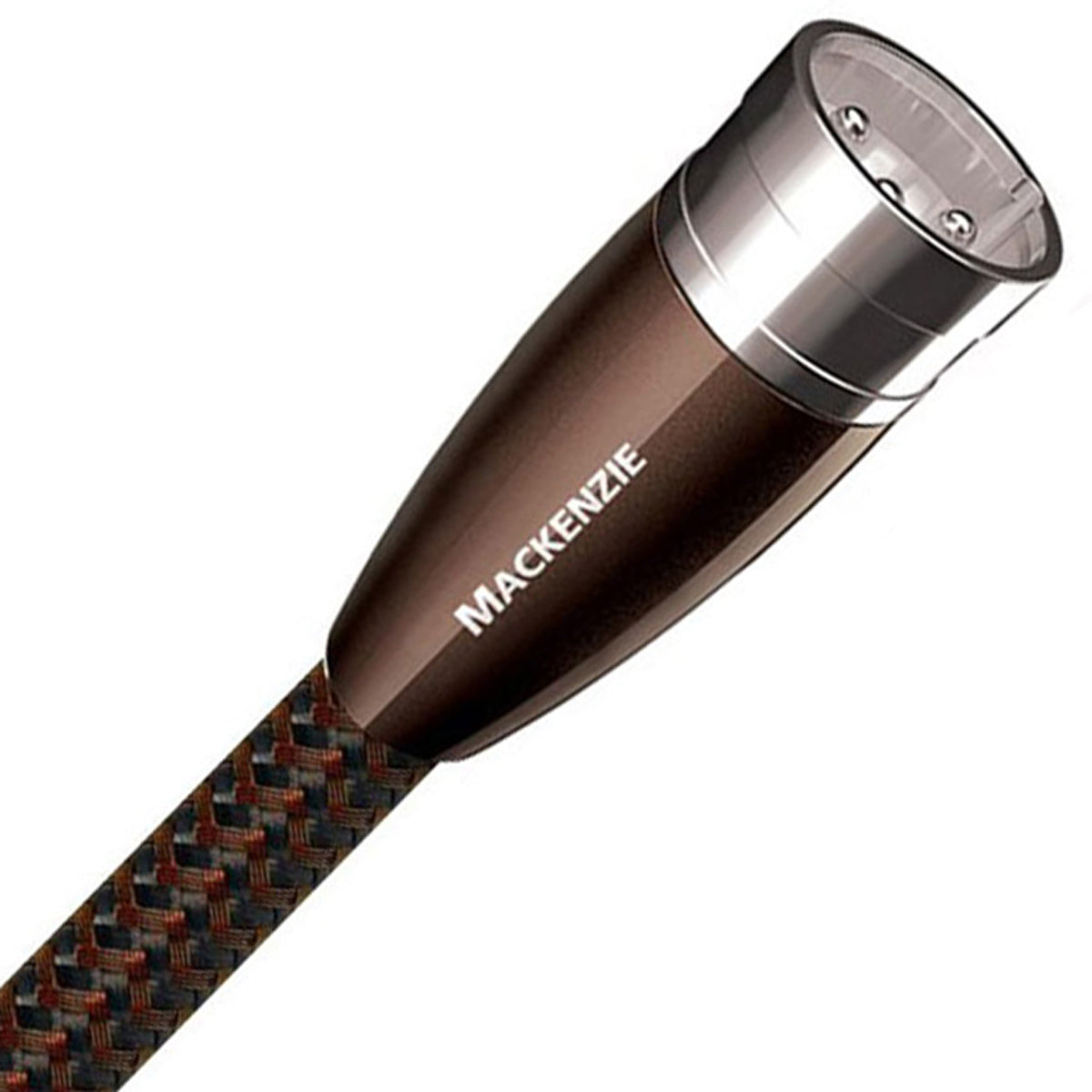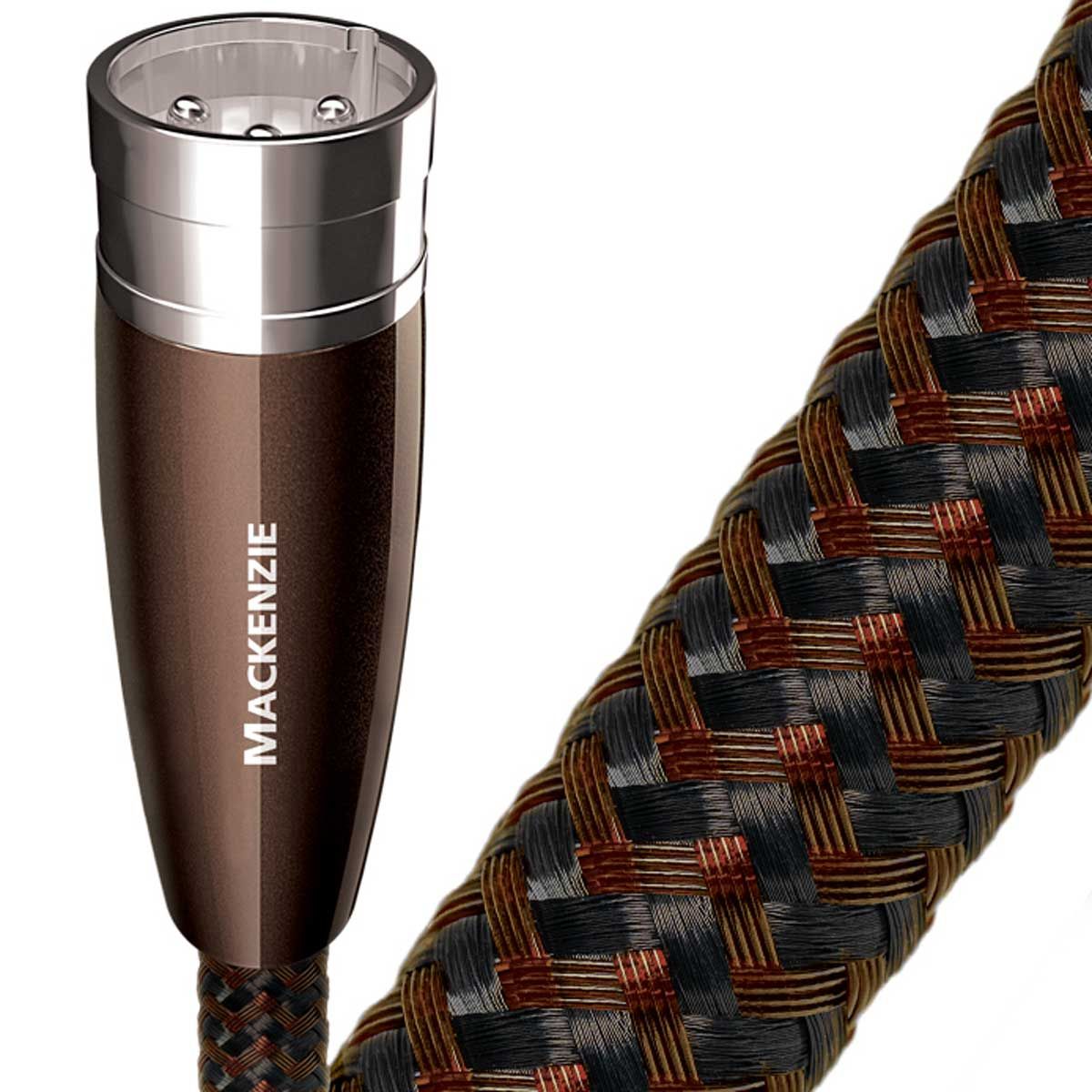

AudioQuest Mackenzie XLR Audio Cable
AudioQuest Mackenzie XLR to XLR interconnect cable is the next up the line from AudioQuest Red River XLR to XLR. You are probably looking at this page because you either have some decent audio gear already or are you are close to purchasing maybe a pre-amp/power amp combination. If you are moving towards more high-end audio equipment, then you will discover that quite a few brands (not all) use balanced XLR type connectors or have provision for both XLR's and RCA's.
AudioQuest are a very respected manufacturer and deliver products that achieve the highest levels of performance and reliability. Their XLR to XLR terminated cables are no exception. If you have audio gear that allows for XLR or balanced line connection, then you can't go wrong with high-quality brands like AudioQuest...and if you really are committed then you should seriously consider Mackenzie with its solid perfect-surface copper conductors and hanging-silver over pure-purple copper connectors.
Why Balanced Cables?
Balanced Cables use two dedicated conductors to provide forward and return paths for signal. The ground connection in balanced configurations is accomplished by means of a third, dedicated, ground conductor. Balanced XLR connectors use large diameter signal pins. They are considered superior by High-End manufacturers and audiophiles to the very common RCA in that they sound better and provide a positive locking action. The Mackenzie series is attractively priced and would suit some of the modest priced valve and home theatre processors and power amplifiers available. There are a number of upgrades over Red River. Let's take a look.
Solid Perfect-Surface Copper (PSC) Conductors: Strand interaction is the single greatest cause of distortion in a cable. Semi-Solid Concentric Packed Conductors avoid many strand-interaction distortion mechanisms. Solid-core conductors like those in Mackenzie offer a complete and compelling solution to this problem. Conductor metal quality is critical for the best cable performance. The conductor surface is the only area of the conductor with 100% current density at all frequencies. The smoothness of the conductor surface is imperative because the surface is a guide rail for the entire energy envelope. The best copper and silver conductor metals have fewer grain boundaries and low oxygen content for low distortion and high performance.
Perfect-Surface Copper+ has an astonishingly smooth and pure surface. Proprietary metal-processing technology protects the wire's surface at every stage of drawing and fabrication. When high-purity low-oxide copper is kept as soft, pure and smooth as possible, it becomes a wonderfully low-distortion PSC+ conductor. PSC+ is manufactured by applying the same exceptional technology to an ultra-pure copper. The resulting sound quality is even more focused and simply less in the way. For over 30 years AudioQuest has pioneered the use of superior metals; yet even we were surprised by the huge leap in performance made possible with Perfect-Surface Technology.
Nitrogen-Injected Hard-Cell Foam Insulation: Nitrogen-Injected Hard-Cell Foam insulation is used exclusively in most of AudioQuest's video and digital audio cables. Similar to Foamed-PE, it is nitrogen-injected to create air pockets. 'Hard' foam is used because the stiffness of the material allows the conductors in the cable to maintain the same relationship with each other along the full length of the cable, thus ensuring that the characteristic impedance of the cable is consistent.
Carbon-Based 3-Layer Noise-Dissipation System (NDS): Preventing captured RF Interference from modulating the equipment's ground reference requires AQ's Noise-Dissipation System. Metal and Carbon-Loaded synthetics prevent most RFI from reaching the equipment's ground plane.
Nitrogen-Injected Hard-Cell Foam Insulation: Nitrogen-Injected Hard-Cell Foam insulation is used exclusively in most of AudioQuest's video and digital audio cables. Similar to Foamed-PE, it is nitrogen-injected to create air pockets. "Hard" foam is used because the stiffness of the material allows the conductors in the cable to maintain the same relationship with each other along the full length of the cable, thus ensuring that the characteristic impedance of the cable is consistent.
Triple-Balanced Geometry: The three conductors in "Triple-Balanced" Mackenzie cables ensure that the XLR plugs' positive and negative signals have equally low-distortion conducting paths. This 100% coverage shield is never used as an inferior conductor.
Cold-Welded Hanging-Silver Directly Over Pure Purple Copper Plugs: Mackenzie's XLR plugs feature new connectors and new pins. The connectors are fastened by cold welding — a solder-less process that uses high pressure and silver paste to minimise signal loss. This plug design allows for a connection devoid of solder, which is a common source of distortion. Because the ground shells are stamped instead of machined, the metal can be chosen for low distortion instead of machinability. By contrast, solder tends to impede the signal, and the heating of the copper conductor during soldering can negatively affect its performance. Purple Copper offers a cleaner, clearer sound than the nickel-plated or OFHC metals commonly found in competing manufacturers' plugs.
Directional: Arrows on the XLR connectors indicate the preferred signal path from the source component to the input.
The History Lesson: Personally we like how Bill and his team come up with names for their products, so this is the story...North America has two Red Rivers, North and South. Red River South has been home to many peoples; it once was the border between the US and colonial Spain, and today forms part of the border between the rival states of Texas and Oklahoma. Red River North forms in a confluence of rivers in North Dakota and Minnesota, but its history is Canada's. The Red River North's early settlers were the Métis, whose ancestry was French and aboriginal Canadian. The Métis in 1869 began an uprising known as the Red River Rebellion, which challenged the Canadian government, eventually leading to the formation of the province of Manitoba.
Main Features & Specifications
- Product Description: A pair of AudioQuest Mackenzie audio interconnects with XLR terminals - males on one end and females on the other end
- Conductors: Solid Perfect-Surface Copper+ (PSC+)
- Dielectric/Insulation: Stiff Nitrogen-Injected Hard-Cell Foam insulation
- NDS: Carbon-based Noise-Dissipation System
- Geometry: 3-conductor Triple-Balanced Geometry
- the separate ground conductor ensures that positive and negative signals have equally low-distortion conducting paths
- Terminations: Cold-Welded, Hanging-Silver directly over pure Purple Copper
- Directional: Yes
- Outer Jacket: Brown braid
- Available Lengths: 500mm; 750mm; 1 Metre; 1.5 Metre; 2 Metre; 3 Metre; 4 Metre
- Custom and longer lengths also available to special order
- AudioQuest Product Code: AQ-MACK-XLR/.5
- Manufacturer's Australian Warranty: 5 years - Does not cover misuse or abuse
Note: Features & Specifications Subject To Change Without Notice. E&OE


